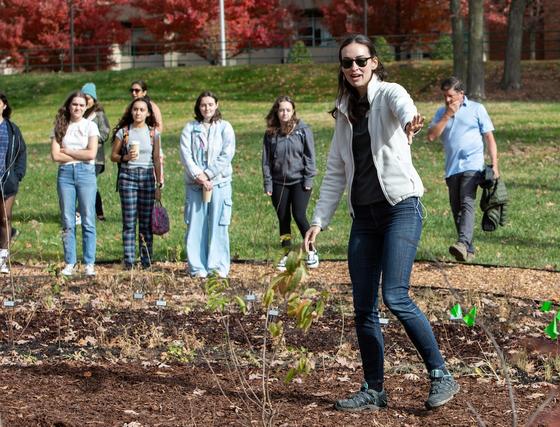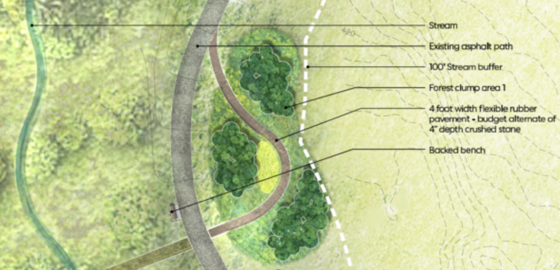There is a Chinese proverb that says “The best time to plant a tree is 20 years ago. The second best time is now.” But what about a forest? Last fall, volunteers planted the beginnings of a “food forest” on George Mason University’s Fairfax Campus.

In November 2023, Mason students, faculty, and staff gathered to help transplant 1,700 plants of more than 50 native species into two groves near the stream behind Student Union Building I between Aquia Creek Lane and Patriot Circle, on what used to be the site of the Student Apartments, which were razed in 2018.
“We are planting America’s first campus-based native food forest dedicated to feeding both human and animal foragers,” said Mason professor Dann Sklarew of what has been aptly named the Foragers’ Forest.
And like most things in the university’s Living Lab, science helped drive many of the decisions, according to Mason graduate student and lead forest maker Sarah Roth.
Roth, who will graduate in May with an MS in environmental science and policy, is leading the project with Sklarew, a professor in the Department of Environmental Science and Policy, and University Sustainability Program Manager Doni Nolan, and with administrative support from Mason’s College of Science, Mason Facilities, and University Sustainability. The forest was also made possible with a grant from Amazon Web Services, which the university matched.

Roth’s designs for the Foragers’ Forest are based on the work of Japanese botanist and forest ecologist Akira Miyawaki. Designed to create forest cover quickly on degraded land that has been used for such purposes as construction, Miyawaki’s method emphasizes using native plants and trying to reconstruct natural plant communities.
Roth said the Miyawaki method also emphasizes mixing the species in the planting and planting very densely—around three trees/shrubs per square meter—to mimic natural patterns of forest regeneration. The Foragers' Forest adheres to these principles by having a high diversity of plant species and mixed dense planting.
“We were surprised to see how many edible or food-producing plants are native to Fairfax County—strawberries, blueberries, black raspberries, hazelnuts, persimmons, oaks, hickories, and even American chestnuts,” said Roth. “We surrounded our tree clusters with a native meadow that will support pollinators and other meadow-dependent wildlife.”
Sklarew said the site also will serve as a new Living Lab space where students can experiment and “act local” to promote food security, wildlife conservation, climate resilience, and other opportunities to advance sustainability.
Faculty from the College of Science and other colleges are collaborating to identify both curricular and Mason Impact projects to use the space.
Pathways, seating, and signage will lead visitors to forage, learn about the site’s principles and propagation, and enjoy the scenery.
“We're excited to highlight Virginia's natural heritage and indigenous foods in this space,” said Roth, who saw Miyawaki’s forests firsthand during a recent trip to Japan.
The Foragers’ Forest joins a prestigious group: More than 3,000 Miyawaki forests have been successfully planted globally.
“What I love about this project is that it blends everything I’m passionate about: native plants, ecological restoration, and bringing people closer to nature,” said Roth. “Our future depends on us building spaces that serve people and wildlife, and we hope this offers a blueprint others can take and improve on.”
Roth began working as a landscape architect for Fairfax County's stormwater planning division this year. “I’m working to restore healthy forests as part of stream restoration projects. The Foragers' Forest project was integral to me making those connections with county staff.”
Laura Powers and Tracy Mason contributed to this story.
Related Stories
- April 26, 2024
- April 22, 2024
- April 19, 2024
- April 18, 2024
- April 1, 2024
